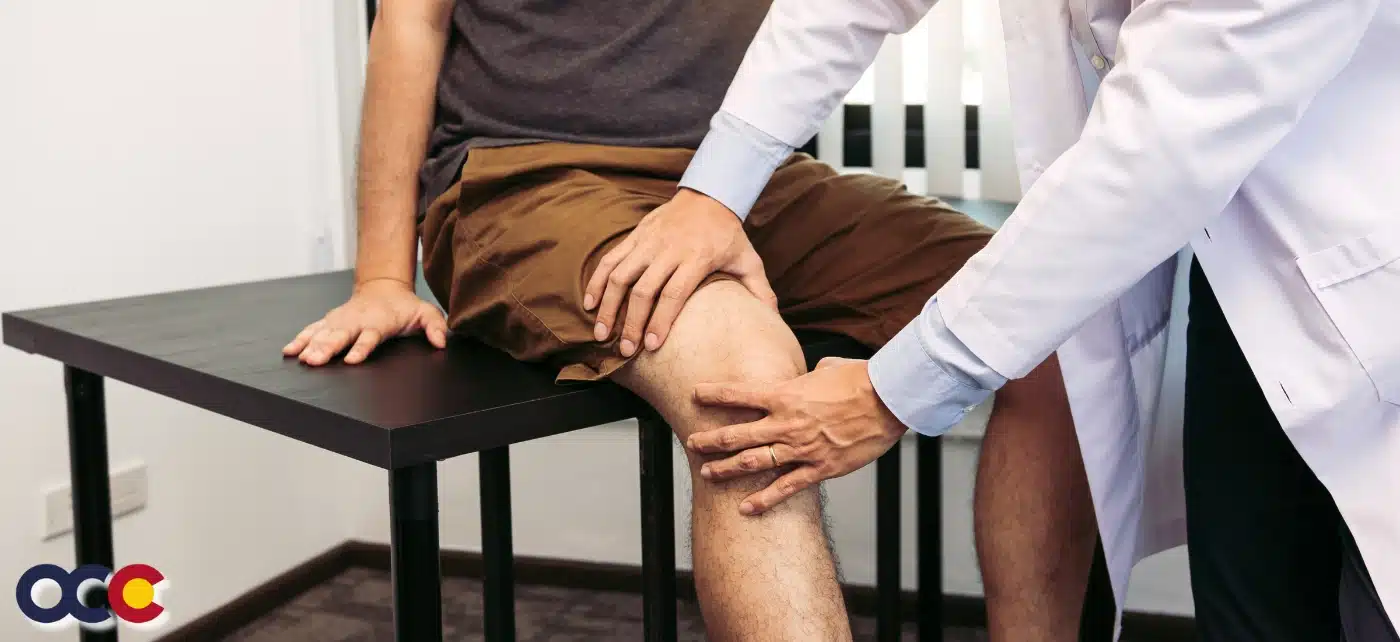There is a good reason why prepatellar kneecap bursitis warrants an immediate medical evaluation and treatment by an experienced orthopedic doctor like those you’ll find at OCC – Advanced Orthopedic & Sports Medicine Specialists in Denver, Parker, or Aurora, Colorado. Untreated, prepatellar kneecap bursitis can develop severe complications that can put your whole life on pause. It can affect your ability to bend or straighten your knee. It can cause chronic inflammation and pain, long-term reduced use of the joint that can lead to decreased physical activity and loss of surrounding muscle. Prepatellar kneecap bursitis can develop infections that can lead to septic shock. Prepatellar kneecap bursitis can be serious. At Advanced Orthopedics, you’ll get serious help.
OVERVIEW
Prepatellar kneecap bursitis is the second most common type of bursitis. Anyone can get it, but more often it affects men between the ages of 40 and 60. The onset of prepatellar kneecap bursitis may be quick as a result of injury, while chronic symptoms may develop slowly over time. Chronic prepatellar bursitis most commonly affects people who have jobs or hobbies that involve frequent kneeling, such as carpentry, house cleaning, plumbing, and gardening. Children are more likely to develop septic prepatellar kneecap bursitis (an infection of the prepatellar bursa).
ABOUT THE KNEECAP
The knee is the joint where the bones of the lower and upper legs meet. The largest joint in the body, the knee moves like a hinge, allowing one to sit, squat, walk, or jump. The knee consists of three bones: the tibia, femur, and patella. The kneecap (patella) is a small triangular bone at the front of the knee that covers the knee joint itself. It is the anchor point for the patellar tendon and the bridge between the quadricep muscles and the lower leg. The kneecap provides leverage for the muscles as they bend and straighten the knee. It also protects the knee joint.
WHAT IS PREPATELLAR KNEECAP BURSITIS?
Prepatellar bursitis or kneecap bursitis is a condition characterized by inflammation of the bursa. There are several bursae (plural for bursa) in the knee joint, and the one commonly affected in patellar bursitis is the prepatellar bursa which is located in the front of the kneecap. A bursa is a small pad-like sac of fluid rich in protein and collagen. These small protective sacs look and act as pillows – cushioning pressure points between the bones and the tendons and muscles near joints. When the bursa sac is repeatedly irritated, damaged, or infected, its thin lining thickens and makes extra fluid. The extra fluid collects in the bursa sac and causes it to swell and put pressure on other parts of the knee. This is called “bursitis”. There are two types of the condition:
- Acute prepatellar bursitis happens when there is sudden damage to the bursa in front of the kneecap. This usually happens from trauma (such as a forceful impact to the knee) or an infection.
- Chronic prepatellar bursitis usually happens from repeated overuse or pressure to the knee such as frequent kneeling. The location and activities that may cause this are why prepatellar kneecap bursitis is also known as carpenter’s knee, housemaid’s knee, carpet layer’s knee, coal miner’s knee, plumber’s knee, and gardener’s knee.
CAUSES
- Frequent kneeling– causes pressure and irritation
- A direct hit to the knee– caused by trauma from falling or getting hit with force
- Playing contact sports—certain sports such as football, wrestling, rugby, and basketball can lead to harsh knee impacts
- Bacterial infection—a scratch, insect bite, or cut on the knee that becomes infected can spread to the prepatellar bursa sac (septic bursitis)
- Inflammatory conditions like rheumatoid arthritis and/or gout—this can cause high levels of uric acid in the blood. Uric acid deposits can spread into the bursa
- Having an immunosuppressive condition—conditions that weaken the immune system, such as diabetes, puts one at higher risk for developing an infection that can cause it
- A difference in the length of the leg
- Obesity and osteoarthritis
SYMPTOMS
The symptoms of prepatellar kneecap bursitis depend on what type it is and how severe the bursitis is. Symptoms include:
- Obvious swelling at the front of the knee that appears as an abscess on the kneecap
- The ability to feel the swollen bursa sac through the skin. It usually feels “squishy” when pressed on
- Tenderness, warmth and redness
- Pain on the middle part of the knee and over the patella
- Pain that may radiate up the inner knee and thigh and/or down to the midcalf
- Increased pain when crossing legs or when rising or sitting for several hours
- Pain that becomes worse during exercise or while climbing stairs
- Pain that increases simply by bending and straightening the knee
- Difficulty sleeping
- Limited range of motion
- Weakness as quadriceps lose strength, causing legs to give out during daily activities
- Fever, achiness, and chills if an infection is present
NON-SURGICAL TREATMENTS
For prepatellar kneecap bursitis that involves just an inflamed bursa, The R.I.C.E. method can be an effective first-line method to ease pain and lessen inflammation: rest, ice, compression, and elevation. Nonsteroidal anti-inflammatory drugs (NSAIDs) such as ibuprofen and naproxen can help reduce pain and inflammation. Acetaminophen can be used as an alternative if one cannot tolerate NSAIDs or are allergic. Corticosteroid injections can help if the medicines don’t relieve pain. Treatment for prepatellar bursitis that involves an infection will need antibiotics which can be taken by mouth or an IV.
WHEN IS SURGERY INDICATED?
If home measures do not work, the doctor may aspirate the inflamed bursa which involves removing the extra fluid that has built up with a hollow needle. If necessary, the bursa may be surgically removed. Usually, this is done by arthroscopic surgery, which is a surgical procedure when tiny incisions are made and a pencil-sized camera is inserted into the knee. Once the doctor can see inside, they can remove the bursa altogether. The surgeon will then look for any damage to the knee and make repairs if necessary.
GETTING THE RIGHT DIAGNOSIS. GETTING THE RIGHT DOCTOR.
Because an inflamed and swollen bursa is so obvious, prepatellar kneecap bursitis can usually be diagnosed from a physical exam. X-rays may be ordered to rule out a bone injury, and a CT scan or MRI can check for an injury to the tissue in or around your knee. At Advanced Orthopedics in Denver, Parker, or Aurora, Colorado, their orthopedic specialists have a wealth of knowledge and experience in diagnosing and managing prepatellar kneecap bursitis. They approach each patient with individualized and personalized care, understanding that this condition presents differently in every case. They also understand the pain and suffering you may be experiencing and make it their mission to help you heal quickly so that you can get moving again and back to work, play, or simply the activities of everyday life. Are you experiencing knee swelling and pain? Schedule a consultation today.

















